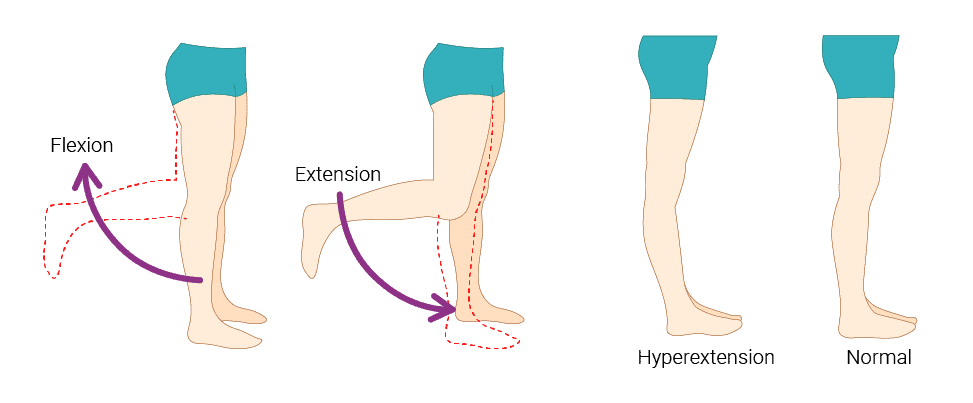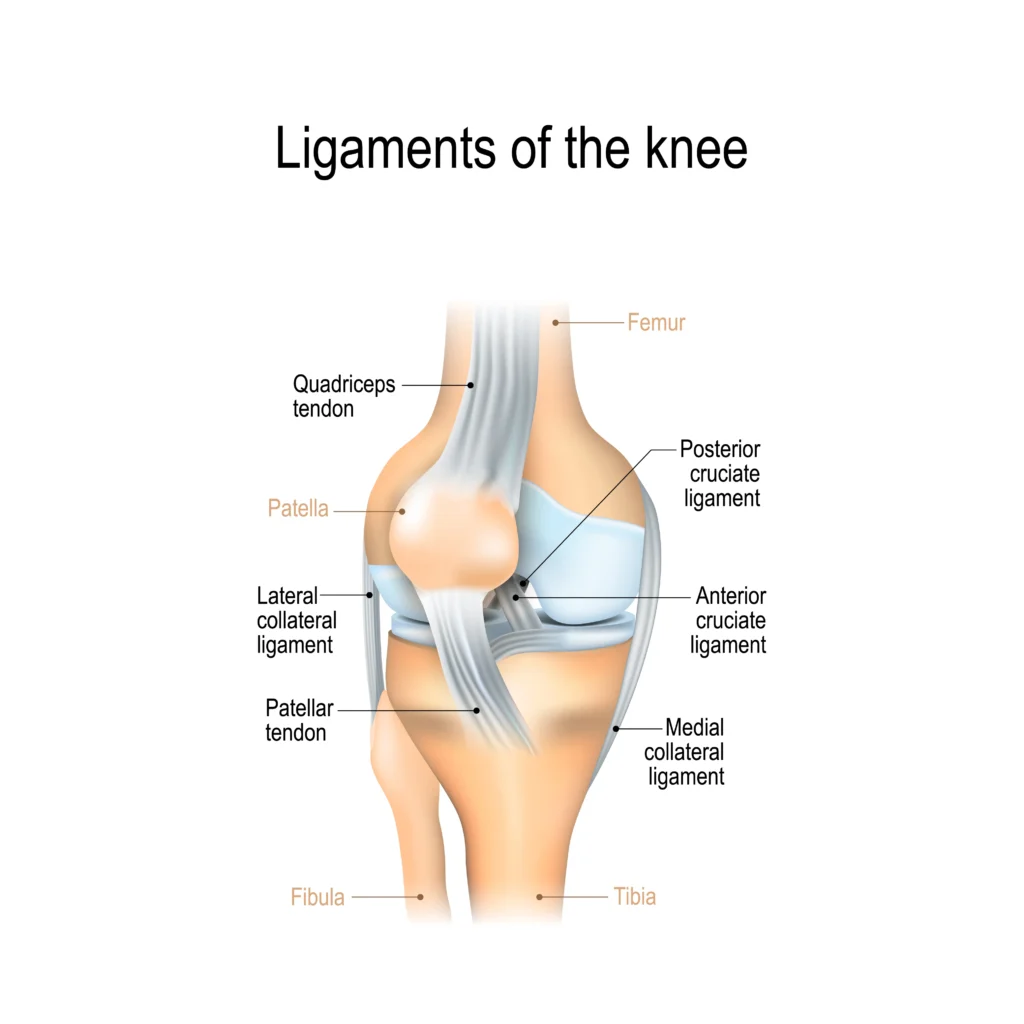Hyperflexion Of The Knee: What You Need To Know

Medically Reviewed By:
Knee hyperflexion occurs when the knee bends too far beyond its normal range of motion. It often happens due to blunt force injuries or during activities like contact sports, sudden stops, or falls. Common symptoms include sharp pain, swelling, and difficulty moving the knee.
Hyperflexion can damage knee ligaments, leading to partial or complete tears, especially in the anterior cruciate ligament (ACL) or posterior cruciate ligament (PCL). In severe cases, surgery may be considered. However, many ligaments can heal naturally, forming scars that may remodel over time. Due to this healing potential, some sprains and strains may recover without surgery.
Procedures using Regenexx injectates utilize interventional orthobiologics to support the body’s natural healing process. They offer an alternative recovery path without medications or surgery.
What Is Knee Hyperflexion?
A typical knee has a range of motion of 130-140 degrees of flexion or bending. Knee hyperflexion occurs when the knee bends beyond this normal range. Excessive bending can push the femur (thigh bone) and tibia (shin bone) out of their normal positions.
When these bones slide out of position, they can pull on surrounding structures, injuring ligaments, tendons, and cartilage.
Knee hyperflexion and hyperextension injuries can happen to anyone. However, athletes in sports like lacrosse and football are at higher risk. These sports involve sudden stops and twists. They also have a higher risk of contact injuries that can cause the knee to bend more than 150 degrees, resulting in hyperflexion.
How Does Hyperflexion Differ From Knee Hyperextension?
Both knee hyperflexion and hyperextension injuries involve abnormal movements of the knee joint.
- Hyperflexion: This occurs when the knee is bent excessively. Hyperflexion can lead to ligament tears.
- Hyperextension: This occurs when the knee joint is straightened beyond its normal range. Hyperextension can cause ligament sprains, tears, or even fractures.

Joint Movements
The knee can move in various directions to accommodate sports and everyday activities. These movements include flexion (bending the knee) and extension (straightening the knee). When the knee is flexed, there is also limited medial and lateral rotation.
Flexion
Flexion of the knee refers to bending the joint, bringing the heel closer to the buttock. This motion is common in activities like crouching or sitting down. Normally, the knee can bend to about 135 degrees. Hyperflexion occurs when the knee bends beyond this point.
Extension
Extension of the knee is the straightening movement that moves the leg forward. This is the opposite of flexion and is crucial for standing and walking. In a healthy knee, extension is typically 0 degrees, meaning the leg is fully straight. Hyperextension occurs when the front of the knee is pushed backward, causing the lower leg to extend too far forward.
Which Part Of The Knee Is Affected During Hyperflexion?
Different knee structures can become involved when the knee joint moves beyond its range of motion or in an abnormal direction. The bones can slide out of place, causing dislocations that exert excessive stress on surrounding muscles, ligaments, and tendons. This can result in tears, sprains, strains, and, in severe cases, ruptures.
In one study, a 54-year-old patient sustained hyperflexion injuries after falling at a ski lift. The fall caused damage to several components of the knee, including an ACL rupture, fractures, and meniscus damage.

Four knee ligaments are commonly affected by hyperflexion:
Lateral Collateral Ligament (LCL)
The LCL connects the femur (thigh bone) to the fibula on the outer side of the knee and stabilizes its outer aspect. Hyperflexion, which stretches the LCL beyond its range, can stress and potentially injure it.
Medial Collateral Ligament (MCL)
The MCL connects the femur to the tibia on the inner knee. Its primary role is stabilizing the knee and resisting valgus stress, preventing excessive inward bending. During hyperflexion, the abnormal bending pulls the MCL, causing it to tear. MCL tears typically occur when a combination of valgus stress and rotation can overstretch the ligament, especially during movements involving hyperflexion.
Posterior Cruciate Ligament (PCL)
Located at the back of the knee, the PCL prevents the tibia from sliding backward. Hyperflexion can force the tibia to move excessively towards the back, stretching the PCL beyond its capacity and damaging it.
Anterior Cruciate Ligament (ACL)
The ACL is in the center of the knee and controls the forward movement of the tibia. During hyperflexion, the tibia may be driven forward too far within the knee joint, causing the ACL to stretch or tear.
What Are The Causes Of Knee Hyperflexion?
As noted, hyperflexion and hyperextension occur when the joint moves beyond its normal range of motion.
Improper posture and knee alignment can contribute to these injuries. Over time, abnormal stress on the knee due to poor alignment can damage knee components. Repeated misuse and poor alignment can alter load distribution, affecting the nerves, ligaments, and cartilage.
Another major cause is physical injuries.
Physical Injuries
Physical injuries can push the knee beyond its normal range of motion. Common injury mechanisms include excessive bending during falls or blunt force impacts.
Examples of injuries that lead to hyperflexion or hyperextension include:
- Sports injuries: Knee hyperextension is common in sports that involve kicking, such as judo, kickboxing, karate, soccer, and football. Quick, sharp direction changes in sports like basketball can also result in forceful knee bending.
- Motor vehicle accidents: Collisions can put undue pressure on the knee, forcing it into a hyperextended or hyperflexed position.
- Falls: Falling directly onto the knee or in a way that twists the leg can cause it to bend or extend beyond its normal range.
- Direct impact: A blunt force trauma to the front of the knee, such as being hit by a heavy object, can push the knee backward.
- Pivoting or twisting movements: Sudden or forceful twisting can lead to excessive knee bending or extending. It is often experienced in racquet sports or dancing.
- Incorrect landing: Landing awkwardly from a jump or fall can strain the knee joint excessively.
- Heavy lifting: Lifting heavy objects without proper technique can cause the knee to bend excessively.
What Are The Symptoms Of A Hyperflexed Knee?
Symptoms of knee hyperflexion can vary in location and intensity and can depend on what ligaments or other knee components are affected. The most common ones include:
Knee Swelling
Inflammation kicks in following an injury. Swelling occurs as part of this inflammation response when fluids accumulate around the injury site.
Knee Pain
Pain arises from strained tissues and injured nerve endings. Following an injury, inflammation often causes discomfort and sharp aches. If inflammation persists after the injury has healed, pain can become chronic and feel like a low, throbbing discomfort.
Knee Instability
Instability occurs when the ligaments that normally stabilize the knee are damaged. This instability can lead to an unreliable knee joint or sensations that the knee will “give out” during activities.
Common Treatments Used For Knee Hyperflexion
Common treatments help reduce swelling and pain after the injury. They can also improve instability and help patients return to daily activities.
RICE Method
RICE stands for rest, ice, compression, and elevation. This at-home remedy helps reduce acute inflammation at the injury site, relieving pain and swelling and improving mobility.
However, this method involves icing, which reduces the blood supply and healing nutrients to the injury site. One study suggests that this action can slow down healing.
Medications
Common medications for knee injuries include:
- Corticosteroids: These are synthetic versions of cortisol, a hormone naturally produced by the body that helps regulate inflammation. Corticosteroid injections can reduce inflammation and offer longer-lasting pain relief compared to NSAIDs. However, repeated use can cause cartilage loss and disrupt normal cortisol production.
Surgery
Physicians may consider surgery if the injury is severe or involves multiple knee components. For example, a ruptured ligament could be repaired surgically to improve stability.
Any surgical intervention carries risks. These include blood clots, infections, and risk of damage to nearby joint components. Additionally, surgical interventions to repair torn ligaments are not always successful. A 2023 study on 46 patients reported “unacceptably high failure rates” of ACL reconstruction surgery at a two-year follow-up.
How The Regenexx Approach May Help With Knee Issues
Components of the knee, like the ligaments, have a natural ability to heal themselves. However, this ability can decrease over time due to injury or aging.
The Regenexx approach uses interventional orthobiologics to support the body’s natural ability to heal. This approach may help ligaments strained or torn during activities like hyperflexion, potentially offering a non-surgical alternative to address orthopedic concerns while reducing the need for medications or surgery.
The Regenexx Alternative To Knee Surgeries
A physician in the licensed Regenexx network will review existing MRIs and scans, examine the body in motion, and possibly use ultrasound to identify potential contributors to pain. This knowledge will help the physician design a customized treatment plan. This plan may include one or a combination of injectates, such as platelet-rich plasma (PRP) and bone marrow concentrate containing stem cells.
The concentrations of the cells in Regenexx injectates are customized to each patient’s needs, ranging from 6X to 20X. The 20X concentration is higher than what is typically achievable by non-Regenexx injectates. Additionally, physicians within the licensed Regenexx network use real-time imaging guidance during injections at the target site, improving accuracy.
Discover how non-surgical treatments may help support your knee mobility. Schedule a consultation with a physician in the licensed Regenexx network to learn your options.
Get started to see if you are a Regenexx candidate
To talk one-on-one with one of our team members about how the Regenexx approach may be able to help your orthopedic pain or injury, please complete the form below and we will be in touch with you within the next business day.

Medically Reviewed By:
